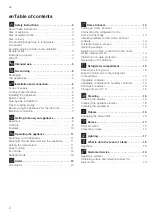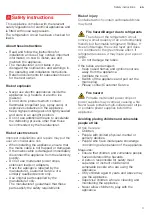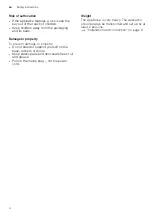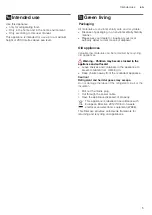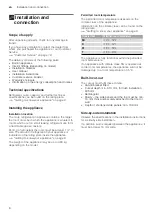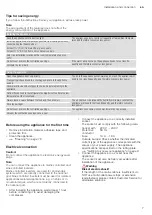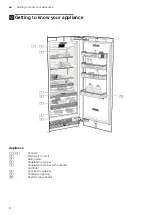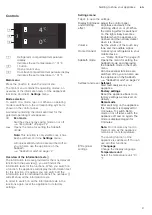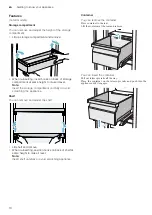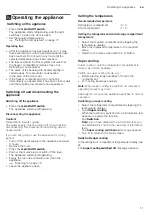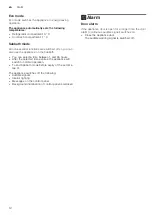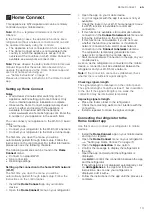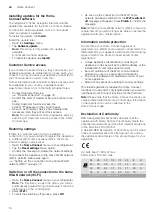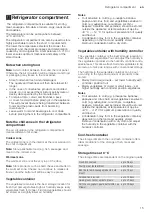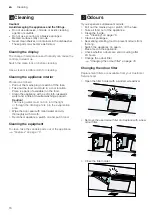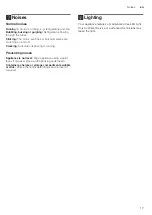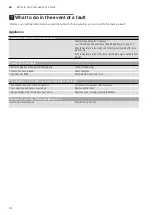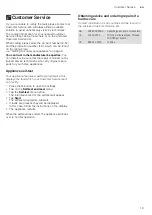
Refrigerator compartment
en
15
U
Refrigerator compartment
Refrigerator compartment
The refrigerator compartment is suitable for storing
meat, sausages, fish, dairy products, eggs, ready meals
and pastries.
The temperature can be set anywhere between
+2°C and +8°C.
The refrigerator compartment can also be used to store
highly perishable foods in the short to medium term.
The lower the temperature selected, the slower the
enzymatic and chemical processes and deterioration
caused by micro-organisms. A temperature of +4°C or
lower ensures optimum freshness and safety of the
stored foods.
Note when storing food
Note:
Avoid contact between food and the rear panel.
Otherwise, the air circulation will be impaired and food
or packaging may freeze to the rear panel.
■
Store food when fresh and undamaged.
The quality and freshness will then be retained for
longer.
■
In the case of convenience products and bottled
goods, do not exceed the minimum sell-by date or
use-by date specified by the manufacturer.
■
To retain aroma, colour and freshness, pack
or cover food well before placing it in the appliance.
This will prevent flavours being transferred between
foods and the plastic parts from becoming
discoloured.
■
Leave warm food and beverages to cool down
before placing them in the refrigerator compartment.
Note the chill zones in the refrigerator
compartment
The air circulation in the refrigerator compartment
creates different chill zones.
Coldest zone
The coldest zone is in the interior at the rear wall and in
the chill compartment.
Note:
Store perishable food (e.g. fish, sausages and
meat) in the coldest zone.
Warmest zone
The warmest zone is at the very top of the door.
Note:
Store products such as hard cheese and butter in
the warmest zone. Cheese can continue to release its
flavour, and the butter will still be easy to spread.
Vegetable container
The vegetable container is the best storage location for
fresh fruit and vegetables.High air humidity keeps leafy
vegetables fresh for longer. Fruit and vegetables should
be stored at a slightly lower air humidity.
Notes
■
Fruit sensitive to cold (e.g. pineapple, banana,
papaya and citrus fruit) and vegetables sensitive to
cold (e.g. aubergines, cucumbers, zucchini,
peppers, tomatoes and potatoes) should be stored
outside the appliance at temperatures of approx.
+8 °C ... +12 °C for optimum preservation of quality
and flavour.
■
Condensation may form in the vegetable container
depending on the food and quantity stored.
Remove condensation with a dry cloth.
Vegetable container with humidity controller
The vegetable container is the best storage location for
fresh fruit and vegetables.You can adjust the humidity in
the vegetable container via the humidity controller and a
special seal. This allows fresh fruit and vegetables to be
stored up to twice as long as with conventional storage.
The humidity in the vegetable container can be set
according to the type and amount of products to be
stored:
■
Mainly fruit or large loads – set lower humidity with
controller position fruit
■
Mainly vegetables or mixed or small loads – set
higher humidity with controller position vegetables
Notes
■
Fruit sensitive to cold (e.g. pineapples, bananas,
papayas and citrus fruit) and vegetables sensitive to
cold (e.g. aubergines, cucumbers, courgettes,
peppers, tomatoes and potatoes) should be stored
outside the appliance at temperatures of approx.
+8°C ... +12°C for optimum preservation of quality
and flavour.
■
Condensation may form in the vegetable container
depending on the food and quantity stored.
Remove condensation with a dry cloth and adjust
the humidity in the vegetable container with the
humidity controller.
Cool-fresh container
The storage climate in the cool-fresh container offers
ideal conditions for the storage of fish, meat and
sausage.
Storage times at 0 °C
The storage times are dependent on the original quality.
Fresh fish, seafood:
up to 3 days
Poultry, meat (boiled/fried):
up to 5 days
Beef, pork, lamb, sausage products (cold
meat):
up to 7 days
Smoked fish, broccoli:
up to 14 days
Salad greens, fennel, apricots, plums:
up to 21 days
Soft cheese, yoghurt, quark, buttermilk, cau-
liflower:
up to 30 days


